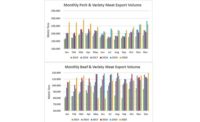For the month of February, 27 percent of U.S. pork production was sold outside of the United States with the incremental value of exports reaching $51.48 per head – versus 25.2 percent and $43.81 last year. Total pork exports jumped 15 percent in value and 8 percent in volume versus February 2010 totals.
At the same time, U.S. beef exports in February accounted for 12.9 percent of total production versus 10.6 percent last year at this time, and the incremental value of beef exports per head of fed slaughter reached $182.12, compared to $126.50 last year. For the month, total beef exports were up 47.2 percent in value and 25 percent in volume over year-ago levels.
Exports of U.S. pork in February reached 172,022 metric tons valued at $434.4 million. For the first two months of 2011, those totals are 337,160 metric tons valued at $831.3 million, increases of 11 percent in volume and 17 percent in value. Mexico, Japan, the Hong Kong/China region, South Korea and Canada remain the top five export markets.
The strength of U.S. pork exports was seen across the board so far this year, with only two major markets (Mexico and the ASEAN region) showing any slippage from last year. In Japan, the leading value market for U.S. pork, exports were up 19 percent in volume and 17 percent in value for the first two months of 2011 to 74,498 metric tons valued at $280.3 million. In addition, Japanese import data show the U.S. market share increased to 45.5 percent of all imported pork – up from 43.2 percent a year ago.
“The trend in Japan, as it is in a number of other Asian countries, is toward increasing reliance on imported foods to meet domestic needs,” said Philip Seng, USMEF president and CEO. “It is critical for the U.S. to maintain a strong presence in markets like Japan, where consumers are willing to pay for high-quality products. This year, 22 nations are exporting pork to Japan in competition for this valuable export market.”
In Mexico – the top export market in volume – the modest 5 percent decline in export volume and 3 percent slip in value from year-ago levels is understandable as higher U.S. pork prices limit growth potential. Even at that, exports to Mexico for the January-February period stand 71 percent higher in volume (94,883 metric tons) and 95 percent higher in value ($168 million) than the global record year of 2008.
The growth leader for U.S. pork exports in February was South Korea, which purchased a record 19,532 metric tons valued at $49.2 million as that nation continues to deal with product shortages driven by a major outbreak of foot and mouth disease (FMD). Monthly export totals to Korea jumped 154 percent in volume and 227 percent in value versus February 2010. For the first two months of 2011, South Korea has purchased 32,715 metric tons of U.S. pork valued at $81.3 million – increases of 143 percent and 198 percent, respectively.
Other key pork export markets include:
- Hong Kong/China: down slightly (4 percent in volume and 9.4 percent in value) for February, but still up 19 percent in value ($81.5 million) and 22 percent in volume (56,429 metric tons) for January-February versus 2010.
- Canada: essentially level compared to 2010, with two-month totals at 26,746 metric tons valued at $89.7 million.
- Central and South America: 11,128 metric tons (12 percent increase) valued at $28.4 million (26 percent increase) for the January-February period.
- Russia: 278 percent increase in export volume and 406 percent jump in value to 8,009 metric tons valued at $21 million for the two-month start of 2011. This is due in part to the limited market access for U.S. pork in early 2010.
A similar trend has emerged in beef exports with strong growth across a diverse base of international markets. For the first two months of 2011, virtually every significant export market showed growth versus 2010 levels.
Exports of U.S. beef in February reached 89,787 metric tons valued at $371.7 million. For the first two months of 2011, those totals are 179,460 metric tons valued at $727.3 million, increases of 24 percent in volume and 45 percent in value. Mexico, South Korea, Canada, the Middle East and Japan are the top five export markets.
Mexico leads the way in volume and value, importing 40,542 metric tons valued at $151.6 million, increases of 3 percent in volume and 22 percent in value over last year as this key market continues its rebound from the global economic slump that affected it more profoundly and for a longer period than many nations.
South Korea consumers continued to show their growing acceptance of U.S. beef by boosting their purchases by 121 percent in volume and 142 percent in value for the first two months of 2011, reaching 28,150 metric tons valued at $120.2 million.
“The success we’re seeing in South Korea for U.S. beef is extremely gratifying,” said Seng. “It wasn’t that long ago that public sentiment was very unfavorable for U.S. beef. But, with the support of Checkoff dollars and the USDA Market Access Program (MAP), we have devoted significant resources to an aggressive “Trust” imaging campaign – now in its second phase – and proactive partnerships with prominent Korean retailers and foodservice outlets. We’re seeing the fruits of those efforts.”
According to the Global Trade Atlas, the gap between Australian beef exports to South Korea and those from the U.S. has narrowed significantly over the past two years. In 2009, Australia’s market share of Korea’s imported beef (based on value) stood at 51.8 percent versus 33.9 percent for the U.S. This year Australia holds a narrow lead of 45.6 percent to 42.6 percent.
Other top U.S. beef export markets include:
- Canada: up 15 percent in volume and 33 percent in value to 24,877 metric tons valued at $123.5 million for the first two months of 2011.
- Middle East: up 37 percent in volume and 78 percent in value to 20,856 metric tons valued at $45 million despite widespread unrest in the region. Egypt once again proved its mettle as a mainstay market for U.S. beef, with increases of 30 percent in volume (16,511 metric tons) and 78 percent in value ($25.9 million), overcoming an uncertain period in which the government was in transition and economic activity was temporarily stalled.
- Japan: despite continued market access limitations (only accepting beef from cattle 20 months of age and younger) up 75 percent in volume and 81 percent in value to 20,359 metric tons valued $106.2 million.
Exports of U.S. lamb continue to be higher in volume but lower in value versus year-ago levels. Two-month totals show 2,621 metric tons exported (25 percent increase versus 2010) valued at just under $4 million, a 10 percent dip. Mexico, Canada and the Caribbean are the top export markets.
Source: USMEF








